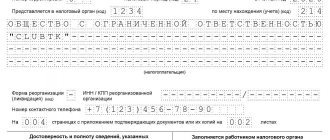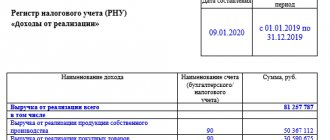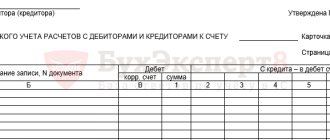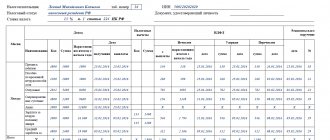What are registers
Due to the fact that the most detailed description of the rules for maintaining tax registers is given in Chapter.
The Tax Code of the Russian Federation, dedicated to profit (Articles 313, 314 of the Tax Code of the Russian Federation), and a small article is devoted to VAT registers. 169 of the Tax Code of the Russian Federation, it would be logical to consider this issue using a set of provisions of the Tax Code of the Russian Federation and the provisions of the Law “On Accounting” dated December 6, 2011 No. 402-FZ. Registers used for tax purposes are designed to register and accumulate information contained in primary documents, accounting statements and analytical tables. At the same time, there are strict requirements for maintaining such registers: there should be no omissions or corrections in them, registration of imaginary or feigned accounting objects is not allowed, etc.
Registers in tax accounting are special forms for compiling and systematizing data for the reporting period. The data entered into the registers must be compiled in accordance with the requirements established by Chapter. 21 Tax Code of the Russian Federation. This information is grouped and registered without reflecting transactions, that is, a record is simply made for the taxable object. In this case, data entry into registers must be carried out continuously and in chronological order.
It is important for the taxpayer to ensure the creation of such an analytical accounting of incoming information that would reveal the procedure for forming the tax base. The registers accumulate and are subject to systematization of information contained in primary documents that are accepted for accounting.
There are registers for tax accounting and accounting. Based on formal characteristics, the following differences can be distinguished:
- accounting registers, which are drawn up in the form of books, contain records of primary documents;
- Only information from accountant’s certificates and calculation tables, which can also be equated to primary accounting documents, is entered into analytical registers for tax purposes.
How to maintain accounting and tax registers , learn from the materials :
- “Accounting registers (forms, samples)”;
- “How to maintain tax registers (sample).”
Tax accounting registers must be formed for all business transactions taken into account for tax purposes. And if, as mentioned above, the procedure for recording and systematizing taxable objects corresponds to the order of grouping and reflection in accounting, then accounting registers can also be declared as tax accounting registers. This means that all objects recorded in such registers will also be used to determine the tax base.
In this regard, the taxpayer, having analyzed his business operations, must choose for which accounting objects he should approve the forms of registers created for tax purposes. This must be done to ensure that all information that is required to correctly determine the tax return figures is reflected.
Registers are drawn up in the form of summary forms both on paper and in electronic format. Moreover, if the registers are maintained in the form of machine diagrams, in accordance with clause 19 of the Regulations on accounting and accounting in the Russian Federation, approved. By order of the Ministry of Finance dated July 29, 1998 No. 34n, it must be possible to print them on paper.
You are allowed to enter your details into the form of tax accounting registers if it is not possible to enter into the proposed standard ones all the information necessary to designate the tax base (Article 313 of the Tax Code of the Russian Federation). It is important that there is no duplication of records.
The need to make changes to the register form usually arises for the taxpayer if the accounting procedure differs from the tax accounting procedure. The format of these analytical reports, the method of maintaining them and reflecting the data are fixed in the accounting policy of the enterprise. Those officials who compile and sign them (responsible accounting employees) will be responsible for the correct reflection of taxable items in the registers.
Register data should be stored securely to protect it from unauthorized modifications. In this case, corrections can be made if an error was discovered and corrected in a timely manner by the person responsible for maintaining the registers. Each correction must not only be justified, but also confirmed by the signature of the person responsible for maintaining the registers, indicating the date.
Registers of the VAT accounting subsystem in 1C: Accounting 8 rev 1.6
Accounting for value added tax is complex, and accounting rules do not provide for the recording of a number of events that are important for VAT calculations. Therefore, the “1C: Enterprise Accounting” configuration takes into account all events related to VAT on registers.
Let us dwell in more detail on some elements from the list of the accumulation register of the VAT accounting subsystem:
- The “VAT Accrued” register is intended to store information about the amounts of VAT accrued for payment to the budget.
— The “VAT presented” register is intended to store information about the amounts of VAT presented by suppliers of purchased values. — The “VAT settlements with customers” register is intended to store information about settlements with customers for VAT accounting purposes. Compared to accounts for settlements with customers, it contains more detailed information about which payment receipts from buyers relate to specific documents for the sale of goods (works, sales documents. - The “VAT settlements with suppliers” register is intended for storing information about settlements with suppliers for VAT accounting purposes. Compared to accounting accounts for settlements with suppliers, it contains more detailed information about what payments to suppliers relate to specific documents of receipt of goods (works), is intended to store information about sales book entries. Based on the data in this register, the report " Sales book" without any additional data processing. - The "Purchases VAT" register is designed to store information about purchase book entries. Based on the data in this register, the "Purchases Book" report is built without additional data processing. - The "VAT on advances" register is intended to store information on the amounts of VAT accrued on received and issued advances and prepayments. You can (and should) check VAT not only using standard accounting reports, but also with the universal reports “Balances and Turnovers”, “List/Cross-Table” (menu “Reports” - “Other”). Let's consider several checks: 1. Register "VAT Accrued" - Report "Balances and Turnovers". If there are balances, then these amounts are not included in the sales book and the VAT return. Such amounts can only relate to sales transactions carried out before 01/01/2006, provided that the VAT tax base before 01/01/2006 was determined by payment. In this case, the register balance and the account balance. 76.N “Calculations for VAT deferred for payment to the budget” must coincide. 2. Register “VAT presented” - Report “Balances and turnover”. The balances must match the account balances. 19 “VAT on acquired assets.” The turnover for expenses in the register must coincide with the turnover for credit 19 accounts, and for receipts - with the turnover for debit 19 accounts. 3. Register “VAT on advances” - Report “Balances and turnover” by type of value “Advances received”. The balances must match the balances on account 76.AB “VAT on advances and prepayments”. 4. “Purchase VAT” register – “List/Cross-Table” report. The correspondence of the turnover on the debit of the account must be observed. 68.02 “Value added tax” in correspondence with the account. 19. 5. Register “VAT settlements with customers” - Report “Balances and turnover”. The register balance must match the account balance. 62 “Settlements with buyers and customers.” Of course, the given list of checks is far from complete; it can be expanded in accordance with the needs of organizations. The question arises, for what reasons are possible discrepancies between the accounting accounts and the registers of the VAT accounting subsystem? One of the most common is the generation of transactions for VAT or for mutual settlements with counterparties for sold/acquired values using manual operations. The result of such actions will be incorrect automatic completion of regulatory VAT accounting documents, such as “Registration of payment to supplier for VAT”, “Registration of payment from buyers for VAT”, “Creation of purchase book entries”, “Creation of sales book entries”. To ensure that such operations are correctly reflected in the VAT accounting registers, there are appropriate documents in the system, for example “Debt adjustment”, “VAT write-off”. There are also situations when changes are made to sales documents or receipts, payment orders after the formation of regulatory documents for VAT accounting. If such errors occurred in the current period, you can correct the situation by refilling the VAT regulatory documents. To correct errors made in the previous period, you can use the “Adjustment of register entries” document. Let’s assume that the organization purchased inventory items (in the program the receipt is reflected in the document “Receipt of goods and services”), VAT on which cannot be deducted, and using a manual operation was debited to the account. 91. In this case, a balance will remain in the “VAT presented” register. When filling out the document “Creating Purchase Ledger Entries”, it will include VAT on the above receipt, and if you do not manually remove this VAT from the document, a VAT refund entry will be generated when posted, and on the account. 19 a credit balance is formed. You can correct the situation using the document “Adjusting register entries” (menu “Operations” – “Documents” – “Adjusting register entries”). In the document, you need to go to the “Accumulation registers” tab, click the “Setting the composition of registers” button, and in the window that opens, check the “VAT presented” register. In the table, add a line with the type of movement “Expense” and fill in the remaining fields in accordance with the document for capitalization of goods and materials.
Using this document, you can adjust any registers. It is recommended to use the document very carefully; if it is filled out incorrectly in the registers, an even greater discrepancy with the accounting data may arise. Alexander Ilyichev
Information taken from the site https://helpf.pro
Register requirements
In accordance with the requirements established by clause 4 of Art. 10 of Law No. 402-FZ for accounting and analytical registers prescribed in Art. 313–314 of the Tax Code of the Russian Federation, the mandatory attributes of any register are:
- its name;
- the period it covers;
- quantities in physical and monetary terms;
- the name of taxable transactions recorded in chronological order;
- signature of the responsible official.
Registers are necessary to systematize and collect information from primary documents, analytical and calculated summary data for their display when determining the tax base. Analytics of all collected tax accounting information should be organized in such a way that with its help it is possible to determine the entire progress of the formation of the tax base.
At the same time, fiscal authorities are strictly prohibited from establishing other forms of documents (Article 313 of the Tax Code of the Russian Federation), therefore the taxpayer should only take care of using the above details in the registers used.
If corrections need to be made to the register, they are made by the person responsible for its maintenance, indicating the date, initials and signature. In cases where the seizure of registers is expected, copies of the seized registers are included in the accounting documents.
Tax legislation defines only general points that taxpayers should adhere to when preparing tax registers. At the same time, the absence of registers is equated to a gross violation of the rules for accounting for taxable items; the fine for such a violation ranges from 10,000 to 40,000 rubles. (Article 120 of the Tax Code of the Russian Federation).
Registers for tax accounting are consolidated forms in which data is systematized without distribution among accounting accounts (Article 314 of the Tax Code of the Russian Federation), and the requirements regarding mandatory details coincide with the requirements for the preparation of accounting documents. Thus, it can be assumed that the documents used in accounting and tax accounting can also be classified as tax registers.
Only if some information is missing in the accounting register, you can add the corresponding details and use the modified version as a tax accounting register.
An enterprise can be held liable only for the absence of those registers that are specified in its accounting policy (Resolution of the Federal Antimonopoly Service of the North-Western District dated October 10, 2005 No. A42-7611/04-15). There is also judicial practice that is positive for taxpayers, according to which an enterprise itself can not only determine the form of registers, but also decide which lines it needs to fill out in them.
Rules for creating registers
Most of the requirements for compiling tax registers are formulated in paragraph 4 of Art. 10 of the Law “On Accounting” 06.12.2011 No. 402-FZ. These include:
- indicating the title of the document;
- a clear definition of the time period for which the document records data;
- reflection of the quantitative and cost characteristics of the operation being carried out;
- indication of the names of the facts of economic activity according to the order of their implementation;
- signatures of persons responsible for maintaining the register.
As noted earlier, tax registers are necessary to register, group and accumulate data from various documented sources to form the taxable base. At the same time, the structure of the register should make it possible to understand without much difficulty the procedure for forming a taxable object for the period.
Tax authorities are not given the right to impose any standard accounting forms on companies, so companies are given complete freedom. At the same time, organizations must ensure that all required details are included in the forms used.
In those rare cases when there is an urgent need to make corrections to these tax accounting forms, it is necessary to put the date and signature of the responsible person next to them. If there is a requirement to provide original documents, you must keep copies of each copy.
Although tax legislation is quite democratic regarding the rules for creating registers, their absence is classified as a gross violation of the tax base accounting procedure and may entail a fine in the amount of 10 to 40 thousand rubles.
Tax accounting registers accumulate information about taxable amounts without using double entry, at the same time, the requirements for their registration are similar to those that apply to accounting documents. Thus, all accounting documents that allow you to achieve your goal can be classified as tax accounting registers. It is advisable to use a self-developed form or report form only if the standard accounting version lacks any data.
A company's liability for violation of legislation regarding registers arises only in the absence of those forms specified in its accounting policies. This, in particular, was stated in the resolution of the Federal Antimonopoly Service of the North-Western District dated 10.10.2005 No. A42-7611/04-15. In addition, there is court practice, according to which the payer independently determines not only the structure and list of details of tax accounting forms, but also which of them and how they need to be drawn up.
What is required to be displayed in the accounting policy
Each enterprise, in its accounting policy approved for tax purposes, also needs to provide for the procedure for maintaining and compiling documents and registers for tax accounting, including VAT. It will be necessary to describe in detail the rules that must be followed when issuing invoices, maintaining books of purchases and sales, as well as log books and other registers.
In addition, VAT payers must provide in their accounting policies:
- frequency of updating the numbering of invoices;
- the procedure for maintaining separate VAT accounting if the taxpayer carries out taxable and non-taxable transactions or applies different VAT rates;
- scheme for maintaining separate accounting of input VAT.
For details, see the material “How separate accounting for VAT is maintained (principles and methods)” .
You should not neglect your right to establish in your accounting policy the list of registers used for tax accounting. This may be an additional argument in a dispute with the tax authority.
You will find step-by-step instructions for filling out accounting policies for tax purposes in ConsultantPlus. Get trial access to the system for free and upgrade to a ready-made solution.
Tax accounting registers: list
All taxpayers must maintain tax records for income tax in special registers. Tax accounting is organized on its own, and the procedure for maintaining it is fixed in the tax accounting policy (Article 313 of the Tax Code of the Russian Federation). Tax registers in which accounting is kept are also developed independently, since tax authorities do not have the right to establish mandatory accounting forms. In this article we will look at what tax registers are, how they are maintained, and provide examples of filling them out.
What VAT registers are there?
Tax accounting registers for VAT include:
- invoice journal;
- sales book;
- shopping book.
Information from these registers is used when preparing a VAT return, namely to calculate the taxable base.
The log of received and issued invoices starting from 01/01/2015 reflects only documents drawn up as part of intermediary business activities, in the implementation of the developer’s tasks or on the basis of the following agreements: agency, commission or transport expedition. Both VAT taxpayers and those who are not VAT taxpayers (clause 3.1 of Article 169 of the Tax Code) must register invoices issued as part of the implementation of these business operations: firms or individual entrepreneurs exempt from the taxpayer’s obligation for value added tax in accordance with Art. 145 of the Tax Code of the Russian Federation, as well as special regime officers who issue (receive) invoices in the interests of other persons on the basis of intermediary agreements, transport expedition agreements or performing the functions of a developer.
The sales book records all outgoing invoices and data on the cost of sales and the amount of tax, broken down by tax rate:
- in columns 14,14a, 15,16 of the sales book, information is entered on the cost of sales taxed at rates of 20, 18, 10 or 0%;
- in columns 17, 17a and 18, the tax amount is broken down into 20, 18 or 10%.
All information for each column is summarized, and the resulting data is transferred to the corresponding lines of the declaration.
The purchase ledger records all incoming invoices in chronological order.
The amount of input VAT from the purchase book is reflected in the VAT tax return for the reporting period (clause 7 of the rules for maintaining the purchase book, approved by Decree of the Government of the Russian Federation of December 26, 2011 No. 1137, hereinafter referred to as Decree No. 1137). The amounts of tax accepted for deduction at rates of 20 and 10% are reflected in line 120 of section 3 of the tax return, approved by order of the Federal Tax Service of Russia dated October 29, 2014 No. MMB-7-3/ [email protected]
Important features are not only the correct execution of VAT registers, but also income tax registers. And ConsultantPlus experts talk about them in detail. Get free demo access to K+ and go to the ready-made solution to find out all the details of this procedure.
Results
Despite the lack of a uniform concept of tax registers in the code, Art. 120 mentions the possibility of applying punishment to the payer in the complete absence of their knowledge. Based on a comprehensive assessment of Art. 169, 313 and 314 of the Tax Code of the Russian Federation in conjunction with Art. 10 of the Federal Law “On Accounting”, it is possible to formulate a list of rules on the basis of which accounting processes in the accounting and tax spheres should be built.
When the existing system of analytical accounts allows you to fully obtain data for tax calculations, there is no need to enter any additional forms: tax accounting will be built on the basis of existing data. It is also possible to enter auxiliary fields into standard forms in order to correctly calculate the tax base.
It is very important to consolidate the list of used registers in the company’s accounting policies, since this can become a decisive argument in a legal dispute. This is due to the fact that inspectorates do not have the right to insist on providing those tax forms that are not enshrined in company policy.
Specifying the topic of tax registers for VAT and being guided by the text of Art. 169 of the Tax Code of the Russian Federation, which states that these are the final forms for registering and grouping primary data, the following options for their practical implementation can be distinguished:
- Journal for recording invoices.
- Book of purchases.
- Sales book.
The entire set of rules, application forms and instructions for preparing these documents are approved in Decree of the Government of the Russian Federation dated December 26, 2011 No. 1137. Using the information provided therein, the taxpayer has every opportunity to correctly fill out and make the necessary corrections to these documents. It is worth noting that the taxpayer himself is interested in the correct maintenance of registers, since they significantly simplify the process of preparing a VAT return.
Similar articles
- Rules for filling out tax accounting registers
- List of accounting registers
- Tax register for 6-NDFL sample
- Development of tax registers for income tax
- Tax accounting registers: what are they and how to prepare them correctly
Procedure for maintaining an invoice journal
The rules for maintaining a journal of issued/received invoices and the approved form of this register are also established by Resolution No. 1137. The journal itself consists of 2 parts, with the first part recording issued invoices, and the second - received ones. According to the current rules, in the invoice journal:
- it is possible to reflect information about intermediary activities in the first and second parts of the journal;
- It is possible to carry out separate registration of corrected invoices, including corrected adjustment documents.
See also the material “How to fill out an invoice journal.”
In accordance with paragraphs. 3, 3.1 and 9 art. 169 of the Tax Code of the Russian Federation, the journal of invoices can be kept not only on paper, but also in electronic format.
NOTE! Only the electronic form of the journal is submitted to the Federal Tax Service.
You should also take into account the norms of Resolution No. 1137 regarding the fact that all pages of purchase and sales books must be laced and numbered. The same resolution also contains requirements for the form of filling out and maintaining books. Let's look at them in more detail.
Requirements of the Tax Code of the Russian Federation for tax registers
Forms of analytical tax accounting registers, which are annex to the accounting policy of the enterprise, serve to confirm data on a par with primary documents and calculation of the tax base (Article 313 of the Tax Code of the Russian Federation). The requirements that tax legislation places on them are as follows:
- It is unacceptable to enter data into the register without observing chronological order and continuity;
- analytical accounting of tax data in registers should reveal the procedure for forming the tax base;
- registers should be stored in such a way as to prevent unauthorized correction of data in them;
- the persons who compose them are responsible for the correct reflection of business transactions in registers; Each correction of errors entered into the tax register must be confirmed by the signature of the responsible person, with a justification for the correction and indicating the date;
- tax accounting data, including registers, constitute a tax secret; persons who have access to them are responsible for disclosing tax secrets in accordance with the law.
Procedure for maintaining a purchase book
The obligation to maintain a purchase book is established for buyers who are VAT payers (clause 3 of Article 169 of the Tax Code of the Russian Federation). You can keep a purchase book in both paper and electronic format. The rules for maintaining and the form of the book are fixed by Resolution No. 1137.
IMPORTANT! Tax authorities will not accept for deduction an invoice signed in facsimile. It will not be possible to defend the right to deduction even in court.
If you enter a corrected invoice into the purchase ledger, you should cancel the erroneous invoice with negative values and enter the corrective invoice with positive values. If an adjustment invoice is submitted at the end of the tax period, you should draw up an additional sheet of the purchase book and submit an updated declaration if the amount of tax claimed for deduction turned out to be overstated.
Learn how to fill out a purchase ledger.
VAT presented, sales 0%
(Accumulation Register.VATPresentedRealization0).
Designed to store information on VAT amounts presented by suppliers of purchased assets associated with sales operations at a zero VAT rate. Filled in upon shipment for export for correct accounting of exports with a 0% VAT rate. Since for receipts from July 1, 2021, goods and materials in case of sale of them or products made from them do not require confirmation for non-commodity goods, then if you do not have the “Commodity Goods” checkbox checked in the “Commodity Nomenclature of Foreign Economic Activity” attribute of the “Nomenclature” directory, the register will not be filled. For export transactions with 0% VAT of goods and materials received before 07/01/2016, accounting is carried out using this register. Thus, the chain for raw materials consists of a regular receipt, which is accepted for credit in the period in which it was carried out, production of products, if any, using these materials, and sales under a contract with the “export” attribute and the VAT rate of “0%” " Upon the fact of this sale, the register “VAT presented sale 0%” is filled in, which from that moment reflects the current state of affairs regarding the offset of the deduction, and the previously offset VAT is restored. Next, as soon as confirmation of the transaction is received, the document “Confirmation of zero VAT rate” is entered, and “Creation of purchase ledger entries” for this period is filled in with the “Submitted for deduction of VAT 0%” checkbox.
Data from the register is used in the report “Statement of submitted VAT on sales at a rate of 0%”, as well as in the regulated report “VAT: Certificate of accounts payable” Register measurements:
Organization (Organization) - organization Invoice (InvoiceFaktura) - source document for the occurrence of inventory items for the operation Status (State) - one of the possible options “Awaiting confirmation”, “Sales confirmed with 0% VAT”, “Sales not confirmed with 0% VAT" Shipment document (Shipment Document) - a document recording a transaction with 0% VAT Type of value (Value Type) - characterizes the meaning of a business transaction (goods, materials, etc.) VAT rate (VAT Rate) - VAT rate VAT account (VAT Account) - account VAT accounting Register resources:
Amount excluding VAT (Amount Without VAT) – Amount excluding VAT VAT (VAT) – amount of VAT Register details:
Event Date(EventDate) – date of the movement event Event(Event) – purchase book event (0% VAT submitted, 0% VAT confirmed) Type of routine operation (Type of RegularOperation) – type of routine operation that created the movement (if it was created by a routine operation) Write-off of batches (Batch write-off) - a sign that this register entry was made on the basis of batch accounting at the time the document was posted
All soft starter registers
Procedure for maintaining a sales book
The sales book records invoices, including adjustment ones, as well as other documents that are provided for by the rules for maintaining the sales book, approved by Decree No. 1137. The same resolution approved the form of this document. The format for maintaining the sales book in electronic form was approved by order of the Federal Tax Service of the Russian Federation dated 03/04/2015 No. ММВ-7-6/ [email protected] (as amended on 04/01/2019).
The obligation to maintain a sales book is assigned to both taxpayers and those who are exempt from paying tax (Articles 145 and 145.1 of the Tax Code of the Russian Federation, clause 3 of the rules for maintaining a sales book, approved by Resolution No. 1137). The obligation to maintain a sales book is also assigned to all enterprises and individual entrepreneurs that are not taxpayers, but perform the functions of tax agents in situations provided for in paragraphs. 1–5 tbsp. 161 Tax Code of the Russian Federation.
As for the procedure for making corrections in the sales book, the moment of their entry plays a big role here. So, if changes are made in the current reporting period, then only the deleted invoice with a negative value is reflected and the corrected document with a positive value is entered (clause 11 of the rules for maintaining a sales ledger). In cases where the tax period has ended, corrections can only be made by filling out an additional sheet of the book for the reporting period in which the erroneous document was registered.
Read about the nuances of filling out a sales book here.
Tax registers and VAT reporting
VAT payers must fill out the following tax registers:
— invoices;
— journal of received invoices;
— journal of issued invoices;
- Book of purchases;
- sales book.
The procedure for maintaining invoices is determined by Art. 169 Tax Code of the Russian Federation
The invoice is issued by the supplier of goods (works, services) no later than five days, counting from the day of shipment of the goods (performance of work, provision of services). This norm is enshrined in paragraph 3 of Article 168 of the Tax Code of the Russian Federation.
An invoice for the cost of goods (work, services) sold is issued by the supplier in two copies. The first (original) is transferred to the buyer. The second remains with the supplier and is filed by him in the journal of issued invoices. Invoices are filed in the invoice journal in chronological order.
The buyer maintains a record of invoices received and files them in the ledger as they are received from suppliers.
Log books for invoices received and issued should be bound and pages numbered.
As a general rule, invoices are drawn up for all transactions recognized as objects of taxation.
Therefore, invoices are prepared in the following cases.
a) when selling goods (works, services) subject to VAT.
In this case, the invoice is drawn up in two copies (one for the buyer, the second for the seller). The VAT amount is highlighted in a separate line;
b) when selling goods (work, services) not subject to VAT in accordance with Article 149 of the Tax Code of the Russian Federation.
Invoices are also issued in duplicate, but without highlighting VAT. The corresponding inscription or stamp “Without tax (VAT)” is placed on the invoice (clause 5 of Article 168 of the Tax Code of the Russian Federation);
c) in case of gratuitous transfer of goods (performance of work, provision of services).
The invoice is issued in two copies.
The buyer who receives such an invoice is not entitled to deduct VAT. Therefore, the received invoice is not registered in the purchase book (clause 11 of the Rules for maintaining purchase books and sales books).
d) when performing construction and installation work for own consumption.
Both copies of the issued invoices remain with the company.
The first copy is registered in the journal of issued invoices, entered into the sales book and serves as the basis for paying VAT on construction and installation work performed.
The second copy of the invoice is registered in the journal of received invoices and in the purchase book and serves as the basis for deducting the corresponding amount of VAT;
e) when transferring goods (performing work, providing services) for one’s own needs.
In this case, the invoice is issued in one copy, filed in the journal of issued invoices and registered in the sales book;
f) when receiving amounts related to settlements for payment for goods (works, services), for example, advance payments.
In this case, the invoice, as a rule, is issued in one copy, filed in the journal of issued invoices and registered in the sales book. Such invoices are not transferred to the buyer (clause 19 of the Rules for maintaining purchase books and sales books).
When receiving advance payments, the invoice must be issued in duplicate. The second copy is filed in the journal of received invoices and registered in the purchase book in the period when the right to deduct VAT calculated and paid upon receipt of the advance was obtained.
If an organization is a VAT payer, but enjoys an exemption from VAT in accordance with Article 145 of the Tax Code of the Russian Federation, it must prepare invoices in the generally established manner.
At the same time, VAT amounts are not highlighted in invoices, but they are marked or stamped “Without tax (VAT)” (Clause 5 of Article 168 of the Tax Code of the Russian Federation).
The Tax Code provides for cases when an invoice may not be drawn up:
— when selling securities (except for brokerage and intermediary services) (clause 4 of article 169 of the Tax Code of the Russian Federation). This rule applies to all taxpayers;
— when banks, insurance organizations and non-state pension funds carry out operations that are not subject to VAT in accordance with Article 149 of the Tax Code of the Russian Federation (clause 4 of Article 169 of the Tax Code of the Russian Federation);
— when selling goods, performing work and providing paid services directly to the population in cash using cash register equipment (CCT), subject to the issuance of a cash receipt to the buyer (clause 7 of Article 168 of the Tax Code of the Russian Federation);
— when selling goods (work, services) directly to the population for cash without using cash register systems in cases provided for by the legislation of the Russian Federation (clause 7 of Article 168 of the Tax Code of the Russian Federation).
In these cases, instead of invoices, valid strict reporting forms or valid primary accounting documents are used (when making settlements with the public through branches of credit institutions, post offices, etc.), which are registered in the sales book.
The presence of an invoice is a prerequisite for deducting VAT on purchased goods (work, services) (clause 1 of Article 169 and clause 1 of Article 172 of the Tax Code of the Russian Federation). For a legal deduction (reimbursement) of VAT, the invoice must be issued in accordance with the requirements established by paragraphs 5 and 6 of Article 169 of the Tax Code of the Russian Federation.
Otherwise, this invoice will not be considered by the tax authorities as a basis for deducting VAT (clause 2 of Article 169 of the Tax Code of the Russian Federation and clause 14 of the Rules for maintaining purchase books and sales books).
After July 1, 2002, a stamp on the invoice is not required.
The corresponding change, excluding from paragraph 6 of Article 169 of the Tax Code of the Russian Federation the requirement for a seal on the invoice, was made to Article 169 of the Tax Code of the Russian Federation by Federal Law No. 57-FZ of May 29, 2002.
Invoices should not have any erasures or erasures.
All corrections made to the invoice must be certified by the signature of the manager and the seal of the selling organization (or the signature of the individual entrepreneur-seller) indicating the date of the correction (clause 29 of the Rules for maintaining purchase books and sales books).
Buyers keep of original invoices received invoices issued
Buyers keep a record of invoices as they are received from sellers, and sellers keep a record of invoices issued to buyers in chronological order.
When purchasing services for the rental of residential premises during a business trip of employees and services for transporting employees to the place of business trip and back, including services for the provision of bedding for use on trains, strict reporting forms (or copies thereof) filled out in the prescribed manner with a dedicated separate The line amount of value added tax is stored by the buyer in the journal of received invoices.
Log books for invoices received and issued must be bound and their pages numbered.
Buyers maintain a purchase book designed to record invoices issued by sellers in order to determine the amount of value added tax to be deducted (reimbursed) in the prescribed manner.
Invoices received from sellers are subject to registration in the purchase book in chronological order as the purchased goods (work performed, services rendered) are taken into account.
When purchasing fixed assets and (or) intangible assets, the invoice is registered in the purchase book in full after the fixed assets and (or) intangible assets are registered.
When importing goods into the customs territory of the Russian Federation, a customs declaration for imported goods and payment documents confirming the actual payment of value added tax to the customs authority are registered in the purchase book.
Invoices issued and registered by sellers in the sales book upon receipt of advances or other payments on account of upcoming deliveries of goods (performance of work, provision of services) are registered by them in the purchase book upon shipment of goods (performance of work, provision of services) on account of advances received or other payments indicating the corresponding amount of value added tax.
Invoices that do not comply with the established standards for their completion cannot be recorded in the purchase book.
The purchase book must be laced, and its pages numbered and sealed.
Control over the correctness of maintaining the purchase book is carried out by the head of the organization or his authorized person.
The purchase book is kept by the buyer for a full five years from the date of the last entry.
It is possible to maintain a purchase ledger in electronic form. In this case, after the expiration of the tax period, but no later than the 20th day of the month following the expired tax period, the purchase book is printed, the pages are numbered, laced and sealed.
Sellers maintain a sales book intended for registering invoices (control tapes of cash register equipment, strict reporting forms for the sale of goods (performance of work, provision of services) to the population), compiled by the seller when performing transactions recognized as objects that are subject to value added tax , including those not subject to taxation (exempt from taxation).
Invoices issued by sellers when selling goods (performing work, providing services) to organizations and individual entrepreneurs for cash are subject to registration in the sales book . In this case, the readings of the control tapes of cash register equipment are recorded in the sales book without taking into account the amounts indicated in the corresponding invoices.
Registration of invoices in the sales book is carried out in chronological order in the tax period in which the tax liability arises.
When receiving funds in the form of advances or other payments for upcoming deliveries of goods (performance of work, provision of services), the seller draws up an invoice, which is registered in the sales book.
Sellers who perform work and provide paid services directly to the public without the use of cash register equipment, but with the issuance of strict reporting documents in cases provided for by the legislation of the Russian Federation, register in the sales book instead of invoices strict reporting documents approved in the prescribed manner and issued to customers , or summary data of strict reporting documents based on an inventory compiled based on sales results for a calendar month.
The sales book must be bound, and its pages numbered and sealed.
Control over the correctness of maintaining the sales book is carried out by the head of the organization or his authorized person.
The sales ledger is retained by the supplier for a full five years from the date of the last entry.
It is allowed to maintain a sales book in electronic form. In this case, after the expiration of the tax period, but no later than the 20th day of the month following the expired tax period, the sales book is printed, the pages are numbered, laced and sealed.
Invoices that have erasures and erasures are not subject to registration in the purchase book and sales book. Corrections made to invoices must be certified by the signature of the manager and the seal of the seller, indicating the date the correction was made.
A VAT return must be submitted by all persons recognized as payers of value added tax, regardless of the presence or absence of objects of taxation in a given tax period. The only exceptions are those taxpayers who enjoy exemption from VAT under Art. 145 Tax Code of the Russian Federation.
In accordance with Art. 163 and 174 of the Tax Code of the Russian Federation, as a general rule, VAT must be paid to the budget quarterly by the 20th day of the month following the expired quarter.
Exemption from the taxpayer's obligation is possible if, over the three previous consecutive calendar months, the amount of revenue from the sale of goods (work, services) of these organizations and entrepreneurs, excluding VAT, did not exceed a total of 2 million rubles. The exemption is granted for a period of 12 months.










